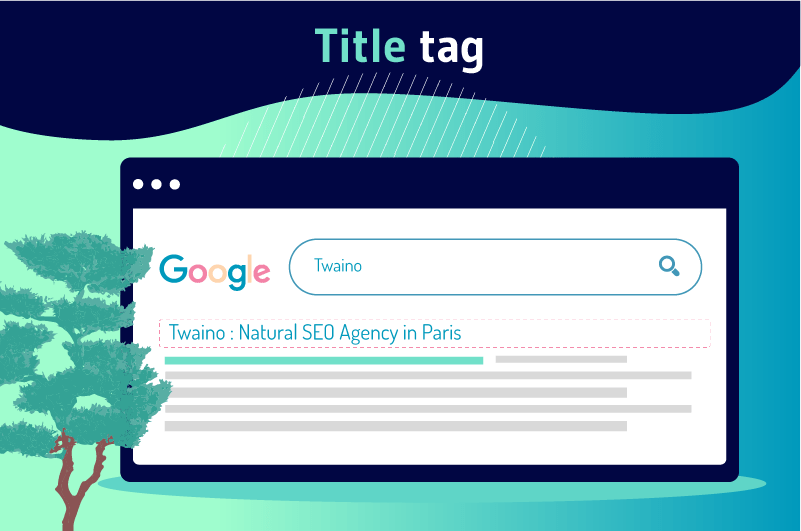A meta title tag is a short phrase placed in the HTML header to indicate to users and search engines the title of a page. Since it is the first element that Internet users see on a web page and in the SERPs, it must be descriptive, catchy, consistent with the content actually displayed and above all well optimized.
The first thing people see in the SERPs when they make a query is the tag title. It is thanks to the latter that they will know or not if the results displayed by the search engines correspond exactly to their searches.
When done right, SEO to the particular page skyrockets.
So:
- What is the title tag?
- Where can we find her?
- Why is it important?
- What are the steps to write it perfectly?
These are all questions to which I will provide more explanation in order to allow you to make the most of meta title tags.
So let’s go!
Chapter 1: What should be understood from the meta title tag?
Before starting this chapter, I would like you to have a fixed idea of the main points to cover:
- What is a title tag?
- Where to find title tags?
- Why are meta title tags important for search engine optimization?
Let’s start with the first!
1.1. What is a title tag?
As its name suggests, a title tag is an element of your web page’s HTML code that indicates its title.
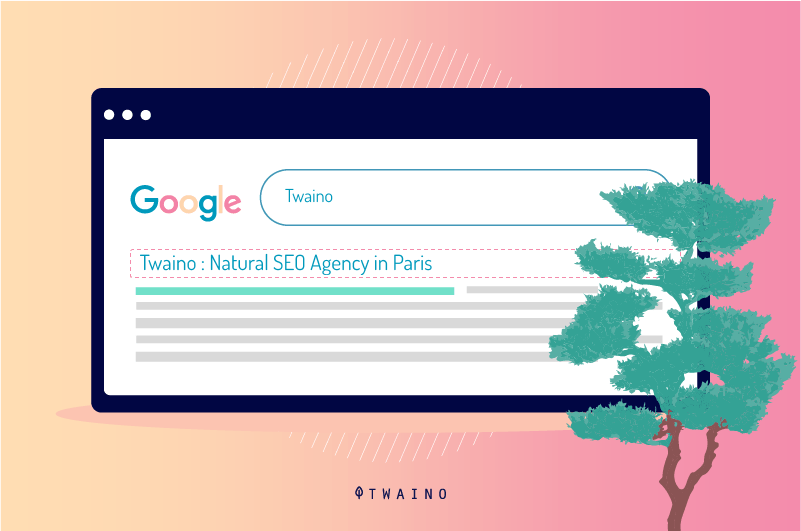
It is often used to let search engine algorithms and users know what the content of the page is.
You can only have one title tag per page. It will appear in your source code as:
<head>
<title> Example title tag </title>
</head>
1.1.1.Example
Let’s take a look at the title of the Twaino home page. In a Google Search Engine Results Page (SERP), the title is displayed at the top, marked with a red square in the screenshot below:

In the source of the page, the title element is placed in the <HEAD> of the page and looks like this:

1.1.2. Basic rule for title tag length
Use these basic rules when it comes to title tag
- length: Maximum length: 60 characters or 575 pixels ;
- Minimum length: 30 characters or 285 pixels.
These lengths are valid in most cases with the various search engines such as:
- Google;
- Bing;
- Yahoo;
- DuckDuckGo.
However, these lengths do not guarantee that your title will be displayed. Ultimately, it’s up to search engines to decide.
1.1.3. Synonyms of title tag
Often, the title tag is also called:
- Meta title tag;
- Title tag;
- Page title;
- Meta title;
- title SEO (due to its relevance to SEO).
Now let’s see where the page titles.
1.2. Where to find title tags?
Most users will primarily find your title tag in three places:
1.2.1. Web browser tabs
The title tag can be seen on your web browser when you open your page in a new tab.

This is especially useful when a user has many tabs open and wants to return to your content .
For this reason, it’s important that your title tags are unique, easily recognizable, and can be immediately differentiated from other open search listings.
1.2.2. The title tag on social media platforms
Your title tag will appear in the head section, accurately describing and letting people know what the page is about and then what they can expect to find when they click on it. link.
Some social networks will allow you to customize your title tag just for their platform’s user experience. An attractive title tag helps attract more visitors to your product or landing page.
1.2.3. Title Tag in SERPs
One of the most important places your title tag will show up is: Search engine results pages (which include Google, Bing, Yahoo, DuckDuckGo, etc.).
The title tag appears as a clickable blue link above the meta description.

This means that if someone finds your webpage by a search query related to your business, the title will be your first chance to make a good impression on the latter and convince him to click on your site.
Adding a title tag to your website is very easy, but writing an effective tag requires time, research, and a bit of skill (which can be easily developed).
But first, you need to know:
1.3. Why are meta title tags important for search engine optimization?
Looking at annual surveys of online marketers and especially SEO specialists, the meta title tag continues to play a vital role in algorithms search engine ranking
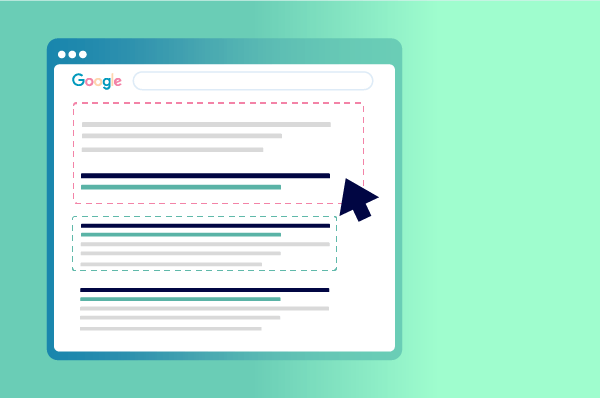
This is one of the major On-page ranking factors. If you want to improve your ranking in organic search results, then you need to take care of your title tags.
Some blogs will tell you that title tag optimization is obsolete these days. This is not true.
Although title tags don’t play the same role in SEO as they did a decade ago, there are still plenty of reasons not to overlook this important part that requires little search engine optimization effort.
Here are the benefits of optimizing your title tags for your SEO strategy (in a good way):
1.3.1. Increase Rankings Through Keyword
Do you need to place your target keyword in your page title to rank well in Google search results?
answer short is: ”YES”.
The longer is that meta tags may not be as important as they once were for search engine results.
From the graph below, we can see that having the keyword in the meta title really has an impact on rankings:
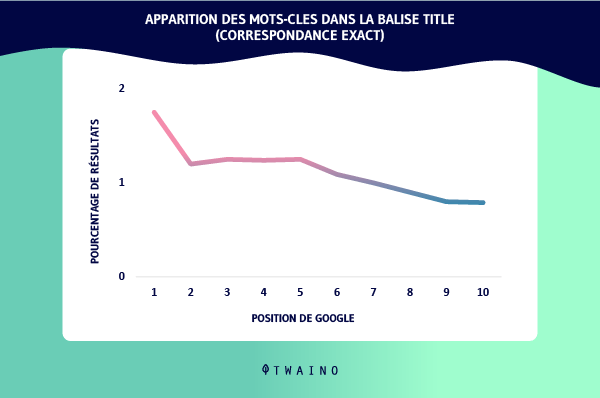
Ahrefs also found that there is a slight correlation between the use of keywords in the title tag and engine rankings of research.
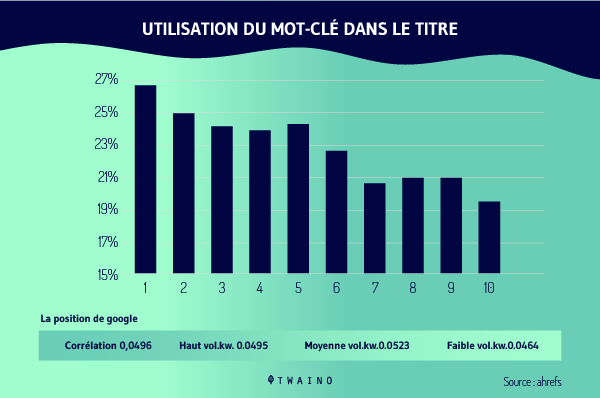
Finally, a final case study by Matthew Barby also indicated that title tags with the presence of keywords are correlated with higher rankings in search engines.
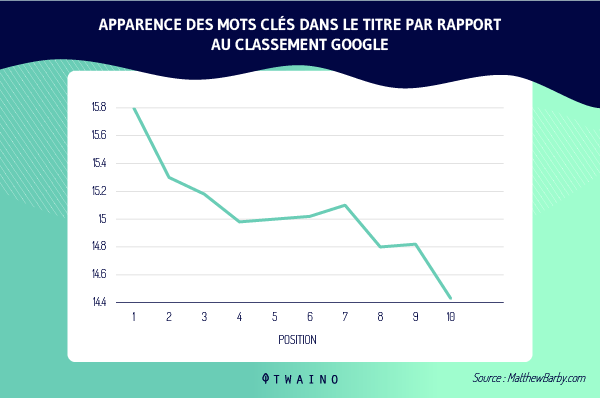
In all, remember thatyour main keyword in the title tag can boost your web page ranking. Just keep in mind that a title tag is a small factor in the larger ranking equation.
1.3.2. Increases CTR (click through rate) when well optimized
Although there is some debate that CTR is a ranking factor, there is no denying that increasing your CTR will increase your page traffic of organic search engine results.
And to be clear: The goal of search engine optimization is to get more natural search traffic. It is therefore important tooptimize your title tags for maximum CTR.
I’ll walk you through best practices later in this article that you can use to optimize your page title tags to accomplish this goal quickly and easily.
Note: In my opinion, there is no advantage in not optimizing the click-through rate. The latter may not be a direct search engine ranking factor, but it does have an indirect impact on search result rankings.
Since search engines often use your title and meta description in SERPs, your CTR will increase when these two tags are attractive.
1.3.3. Social media
When OpenGraph, TwitterCards and Schema.org are missing when sharing a URL, social media uses the title tag as the title. Having a good headline when your page is shared on social media will also improve your website’s CTR.
While we recommend populating OpenGraph, TwitterCards, and Schema.org markup for all pages, you should always have a fallback plan: The title tag.
These are three important reasons why you need to optimize your title tag. Now let’s see how to write a high quality title tag yourself.
Chapter 2: How to write the perfect title tag?
In this chapter, I will give you all the tips you will follow to create your title tags that will attract the attention of users and search engines:
- Five main factors to create a flawless page title;
- 19 more easy ways to optimize your title tags for SEO.
We begin !
2.1. 5 main factors to create a perfect page title
The perfect title tag consists of the following components:
- Excellent readability
- Relevant keywords
- Call to action
- Good length
- Uniqueness
If you keep these components in mind, you will get the most out of your title tags. Before we dive into what makes a good title tag, let’s take a minute and look at this example.
Example: Law Firm New York
One of the results I got from Google when searching for “law firm New York” is:

This title tag can be greatly improved. My assessment:
- Readability: The readability of the title is average. Adding hyphens (“–”) in the title tag decreases readability. On top of that, the title is truncated, which also hurts readability.
- Relevant Keywords: The title tag is not very relevant. What does ” New York – Céline Carsalade, Lawyer St Barth FWI – right of… ” have to do with the request of Internet users? Also, using keywords in this title tag is not good because the applicable keywords are at the end.
- Call-to-action: In this case, the call-to-action requirement does not really apply.
- Length: The meta title is too long. Google truncated the title in the example above.
Wouldn’t the title tag below be much better? They even introduced “NY” as an acronym keyword.

Now let’s see more details about the main factors:
2.1.1. Excellent readability
Focus on the user when writing title tags: First and foremost, the title should be easy to read.
- Avoid page titles written in UPPERCASE or lowercase letters only. You can sometimes mix the two and use capital letters to emphasize certain parts of the title tag;
- Avoid repeating special characters such as hyphens (“–”), pipes (“|”), or commas (“,”) in page titles;
- Write an informative and scannable title tag for the user.
2.1.2. Relevant Keywords
First, do stuff your titles with keywords.

This will dilute the concentration of keywords and you may not rank for none of them. So make choices.
Using the most important keywords at the beginning of your title tag tells search engines that these are the most relevant keywords for the page in question.
Ideally, just use one or two keywords and write an attractive title. Think in terms of key phrases instead of separate keywords.
Example:
Suppose these two keywords are the most important for your page: Content Optimization and Service (in this order).
Then, combine these keywords with the keyphrase : Content optimization service… instead of Content optimization, optimization service…
Butsometimes it’s just not possible to build a keyword phrase and you have to fall back to a general title tag structure like:
- Example 1: Main keyword, secondary keyword | Brand
- Example 2: Main keyword and secondary keyword – Brand
2.1.3. Include a call to action
Choosing relevant keywords is important, but choosing the right words for the rest of the title is just as important. Carefully chosen words will activate a potential customer.
Examples:
- Do you manage an online store? Include the words: Buy or Promo…
- Do you run a consulting firm? Include in the page title the word: Rent…
- Is your website educational? Include the word: Learn…
- Is your page for a webinar or newsletter? Include the word Subscribe…
In short, think of the keywords that will activate your target group and incorporate them into the title.
2.1.4. Title tag length in search engines
There is no perfect title tag length. Page title length is actually a very complex topic, as you need to consider different search engines, operating systems, and devices.
This section describes everything you need to know about meta title length.

The length of the title is crucial not only for SEO, but also for the user experience, as the areas in which they are displayed usually have limited space.
Browser tabs only display a small snippet of a title tag, unless you hover your cursor over the tab, in which case the entire title tag should display.
Safari will display a larger amount at the top of the browser although for the majority of Mozilla and Internet Explorer users the title tag will usually be cut off in the browser tab.
The meta title tags displayed as the anchor text of links on social media differ in length on each social platform and hence it is very difficult to give a straight answer as to the length of social media.
The general rule is to stick to a small number of words.
The main concern with the length of title tags is how they will display on search engine results pages.
2.1.4.1. Characters vs Pixels
Regardless of the search engine, in each SERP, the space available for the title is limited. Bing, Yahoo and DuckDuckGo recommend using as many characters as possible.
However, Google advises to use a maximum of pixels. This makes sense given that it’s much more precise than characters. It takes into consideration that characters such as ” W, M, etc.» take up much more space than « !,i,l, etc. “.
2.1.4.2. Title tag length in Google
A title in Google SERPs has a maximum length of 600 pixels. Considering some margin of error, we recommend sticking to a maximum length of 575 pixels. Typically, this translates to 60 characters.
If your title tag is too short, Google may use one of your titles (H1-H6) instead. To avoid this, make sure your title tag is at least 30 characters long.
In summary: Title tag length for Google
- Maximum length: 60 characters or 575 pixels
- Minimum length: 30 characters or 285 pixels
Please note that the tablet and mobile versions of Google have a larger maximum length for the title tag, but it is not (yet) possible to define specific title tags for different devices.
Therefore, I recommend sticking to the maximum length for desktop to make sure the title adheres as much as possible to Google’s constraints.
2.1.4.3. Title tag length in Bing
Bing recommends using a maximum title tag length of 65 characters. Our own research has shown that 65-character are often cut off in Bing.
For this, it is advisable to limit them to a maximum of 60 characters when optimizing specifically for Bing.
Like Google, if your title tag is too short, Bing may use one of your titles (H1-H6) instead. To avoid this, make sure your title tag has at least 25 characters.
Please note that for Bing, there are no different rules per device regarding maximum title tag lengths.
2.1.4.4. Title Tag Length in Yahoo
Yahoo doesn’t give much guidance in its help section on minimum and maximum title tag length. Our own research has shown that Yahoo SERP allows a maximum width of 553 pixels.
This roughly translates to 65-70 characters. However, we haven’t seen this full width used, nor have we seen title tags with this many characters displayed.
In practice, a significant number of title tags above 50 characters are truncated. Therefore, it is advisable to stick to a maximum of 50 characters.
Still like the two previous cases, if your title tag is too short, Yahoo can use one of your headers (H1-H6) instead. To avoid this, make sure your title tag has at least 25 characters.
Please note that for Yahoo, there are no different rules per device regarding maximum title tag lengths.
2.1.4.5. Title Tag Length in DuckDuckGo
While DuckDuckGo isn’t very informative about their advice on how to optimize pages for their search engine, our research has shown that when you stick to a maximum of 65 characters, you won’t have a problem.
Like the other search engines we’ve discussed in this article, if your title is too short, DuckDuckGo can use one of your headers (H1-H6) instead. To avoid this, make sure your title tag is at least 25 characters long.
2.1.5. Unique title tags for each web page
This criterion is vital for each page. Having duplicate title tags is confusing for users and search engines because the title is a big differentiator.
Search engines in particular will have a hard time choosing the right page to rank for embedded keywords. Don’t rely on solutions likeCanonical URL to fix this problem for you.
Now, we will see the direct procedure to follow to create an SEO-optimized title tag.
2.2. 19 Easy Ways to Optimize Your Title Tags for SEO
Since we’ve already established that a good title tag is an effortless way to optimize both your SERP ranking and your CTR, we’ll cover the exact procedure in this section. to create one.
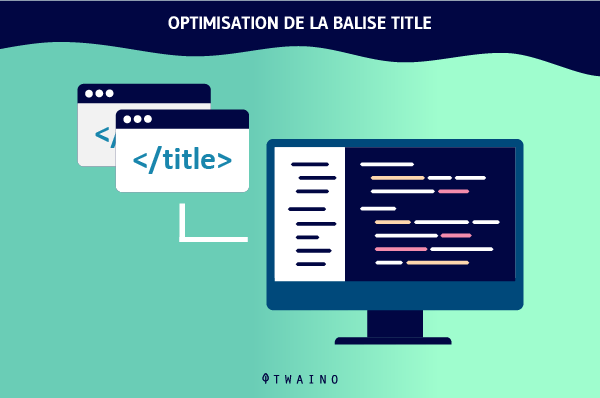
Here are 19 ways to optimize your title tags for better rankings:
2.2.1. Focus on Content First
That’s right. First, the action to take is to ensure that your SEO content is of the highest quality possible.
No matter how well you optimize your title tag, if the page itself is low value, you’ll have a high bounce rate, which can cause your SEO to plummet.
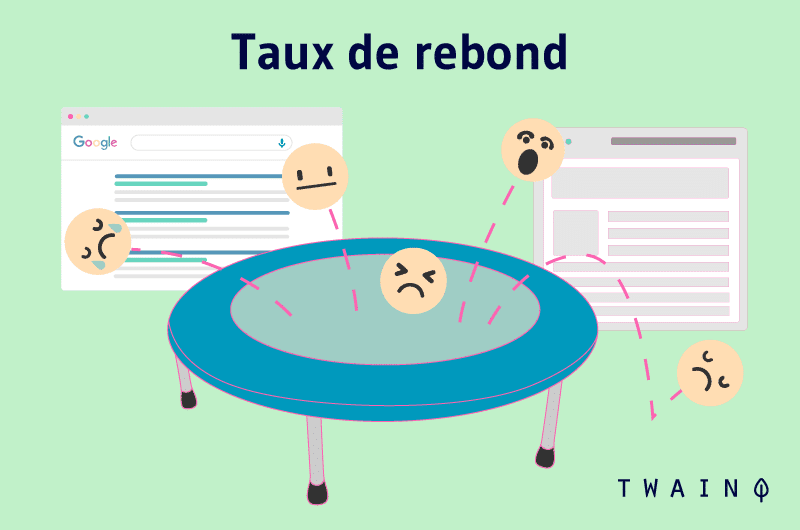
Getting the click is important, but getting visitors to stay longer, visit more a page or achieve a goal is what you should be aiming for. This is only possible if you create SEO content .

Do Don’t take this step lightly!
2.2.2. Identify the type of page
How you create your titles will depend on the type of page. For example, optimizing a title tag for a product page will be very different from optimizing a blog post.
There are different types of SEO-focused pages that a website can have:
- Homepage;
- Category pages;
- Product pages;
- Local Pages;
- blog posts;
- Etc.
2.2.3. Satisfy searcher intent
This applies to both your title and the page itself. The best way to satisfy the searcher’s intent is to think like him.
There arecategoriesof searcher intent:
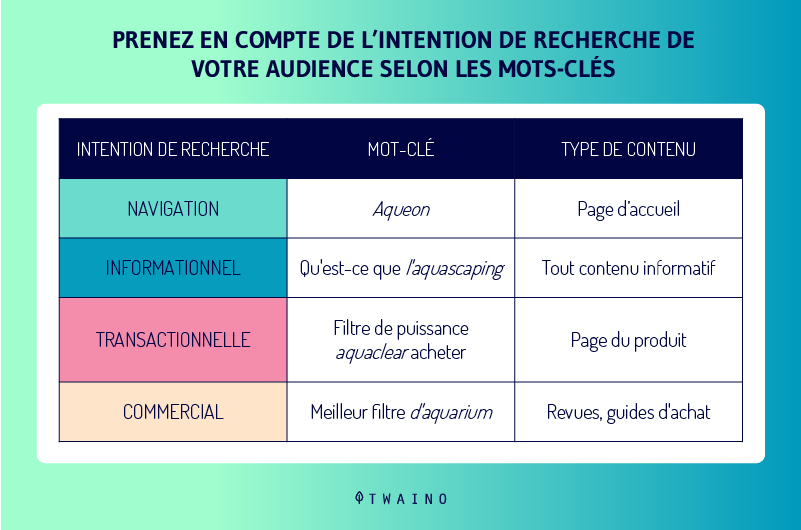
- Informative – These are top queries such as “ what is SEO ”.
- Comparison – These are queries like: “Ahrefs vs Moz”.
- Transactional – These are queries such as ” Moz Free Trial “.
- Navigation – These types of queries are labeled as ” Twaino “. This means that the searcher already knows your brand or may already be a customer.
Most keyword phrases will fall into one or more of these categories.
Your title should address the search intent behind the keyword you are targeting. You should avoid ambiguous terms. Make it as clear as possible to the researcher.
2.2.4. Put your main keyword front and center
If you’re thinking about creating your title tags from a searcher intent perspective, it would make sense to put the keyword front and center. If someone searches for “ best baseball cleats ,” they are likely to click on a result that features that keyword prominently.
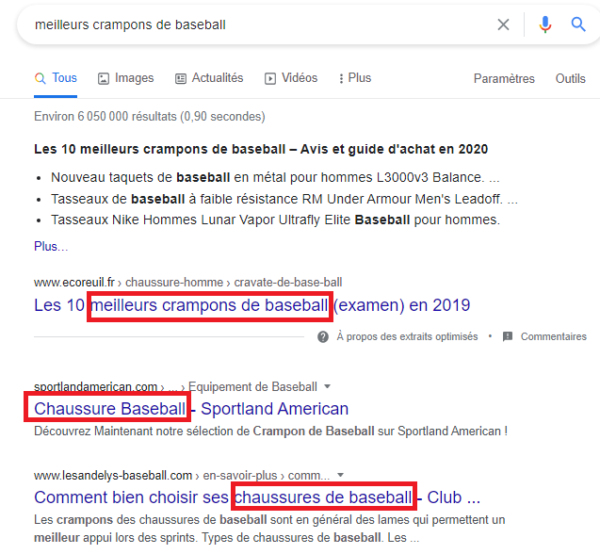
Keep in mind that this does not mean your keyword has to be the first in the title tag. It just has to be at the beginning.
2.2.5. Make sure you’re writing for searchers, not search engines
Yes, put your keyword in your title tag, but don’t do this:
“SEO company | SEO Agency | Chicago SEO Company »
There are several reasons why you shouldn’t include more than one keyword in your title tag:
- It’s not necessary
‘s algorithms are much more sophisticated than before. Specifically, Google’s Hummingbird is designed to better understand content.
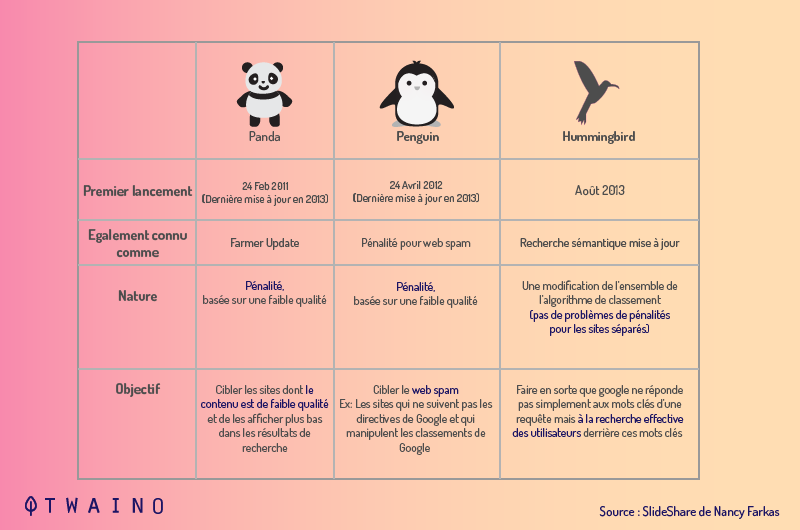
This means it can identify synonyms and variations of your keywords. Therefore, you don’t need to insert keyword variations in your title tag.
Instead, you can place keyword variations or synonyms naturally into your content, so you’ll always perform well for them.
- You should only target one main keyword phrase per page
Although there are some exceptions to the rule (authoritative websites), you should aim to target one main keyword phrase per page.
2.2.6. Use shorter titles
Research by Matthew Barby found that shorter titles tend to perform better in Google:
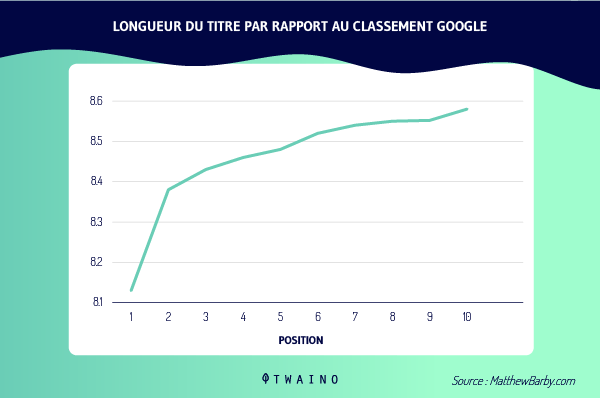
Try to stay under 60 characters (including spaces).
If you’re having trouble keeping it under 60 characters, follow these tips:
- Avoid using uppercase letters in your title tag, as they take up more space than lowercase letters;
- Avoid using punctuation if necessary;
- Remove redundant or repetitive words;
- Use short sentences instead of long, complicated sentences.
2.2.7. Describe what’s on the page
When your web page appears in search engines, many people will decide whether or not to click based on your page title.
If they click through and land on a web page that is not what they expect based on the title, they will immediately click the back button and look for another result in the SERPs.
You need to ensure that your title tag provides an accurate description of what people will see when they choose to visit the webpage.
When people’s expectations match what they see on the page, it results in a bounce rate and longer time spent on the site.
These latter metrics are signals that tell Google that your page is valuable and should maintain a high ranking.
More importantly, it creates a better experience for your visitors. You need to make every visitor enjoy what they see and hopefully come back for more. If your title tag is unclear, this is less likely to happen.
2.2.8. Write UNIQUE titles for each page
You should not allow yourself to have the same title on two different contents of your website.
“ Headings are essential to give users a quick overview of the content of a result, which is why they are relevant to their query. This is often the main piece of information used to decide which result to click on. It is therefore important touse high quality titles on your web pages. – (source: Google).
For this, no page (that you want to index in Google) must have the same title. The easiest way to find duplicate page titles is to use Screaming Frog SEO Spider.
Open Screaming Frog SEO Spider, enter the target domain and click on the “ Page Titles ” tab:

Then click on the “Filter” drop-down menu and select “Duplicate“:
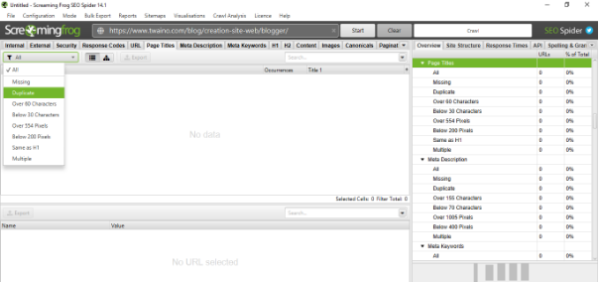
Sort list by “ Title 1 ”:

You only need to worry about duplicate titles tags only if your page is indexed. The new version of Screaming Frog makes this super easy with their new “ Indexability ” column.
2.2.9. Create a keyword variation list
I also create a keyword variation list whenever I find a new primary keyword to target. For example, my main keyword for my backlinks guide is “ backlinks ”.
But obviously my title couldn’t just be “ Backlinks | Twaino ” because it’s boring and I risk losing long tail traffic.
For this, I searched for relevant keyword variations that I could naturally add to the title.
Ahrefs Keyword Explorer is perfect for this task.Enter your main keyword, launch the analysis, then click on “Exact expression“:
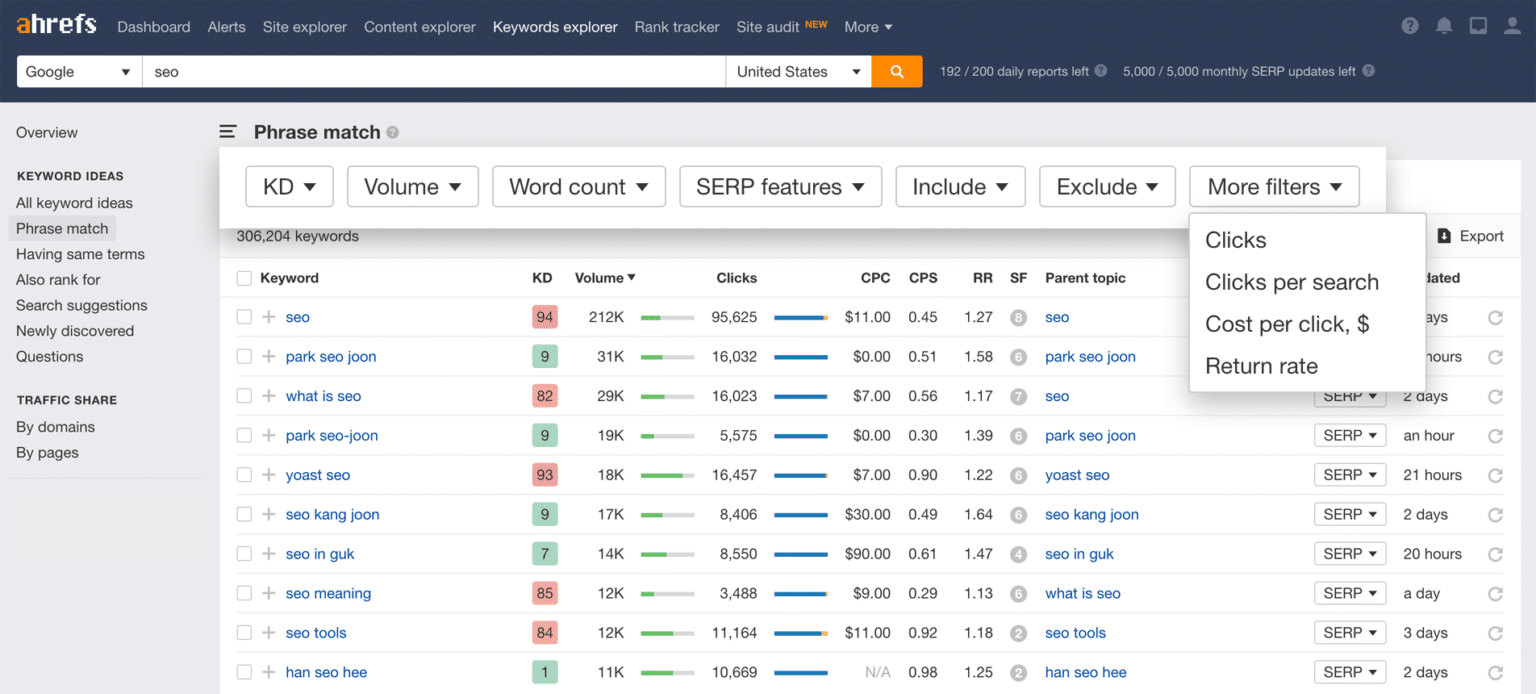
This section is a gold mine for finding keyword variations for your title.
You can also use UberSuggest or Keywords Everywhere to build your list of keyword variations (both are free).
Although you may not be using 99.9% of these variations in your title tag, a large percentage of these keywords may be scattered across your page.
2.2.10. Emphasize freshness
A principle of persuasion is that people like “new” things. In fact, something that is simply ” new ” can be a great driving force.
Do you know someone who prefers the obsolete to the benefit of the new? That’s rare, which is why emphasizing ” freshness ” in a title tag works really well.
Example:
When you see a training course using “ 2.0 ” in their title, know that they are emphasizing freshness in this way.
Some ways to incorporate freshness into your title tags is to use one of the following words:
- New;
- Updated for this year;
- New data;
- Etc.
2.2.11. Use curiosity terms in your title tag
The strategy is simple: use one of the following words in your title tag: “ How ”, “ What ”, “ Why ”, “ When ”, “ Where ” or “ Who “.
- How to {create | learn | to build | to use | fired from | increase | get | do}…
Example:
How to buy a domain name in 6 steps? | Twaino
How To Build Backlinks (Complete Guide) | Twaino
- What is {…}?
Example:
What is SEO? [The Simple & Complete Guide] | Twaino
What is negative SEO and how to … – Twaino
- Why
Example:
Why SEO is essential for an e-commerce site – Twaino
Why and How To Work Long Tail Keywords – Twaino
- When
Example:
14 Reasons To Absolutely Avoid Blogger [and When To Use It] – Twaino
- Where
Example:
The Complete Guide to Where to Place a Canonical
2.2.12. Use numbers
Also called listicle, this technique is super effective. According to a study, 36% of participants preferred headlines containing numbers:
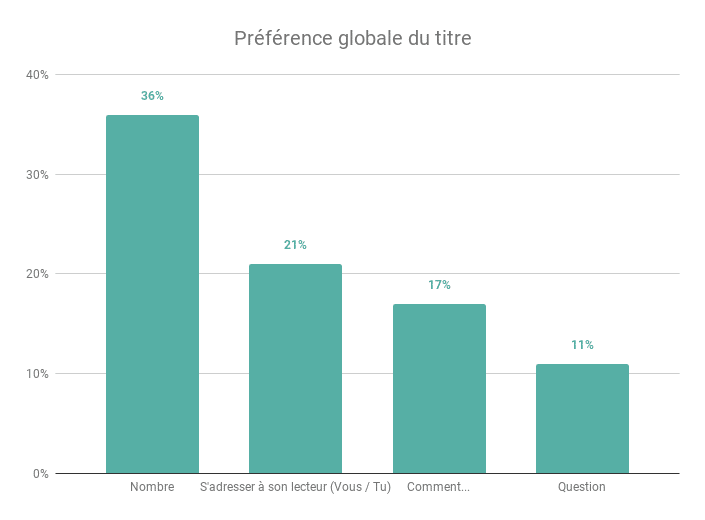
An example of an effective list post is:
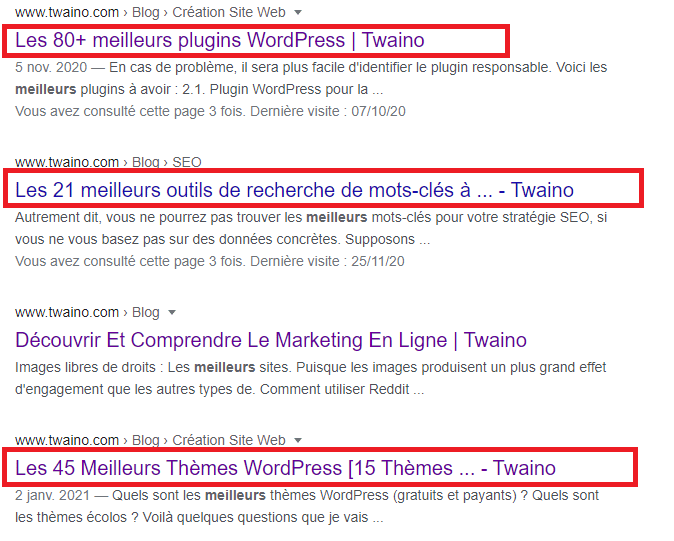
2.2.13. Use the clickbait methodor to create your title tag
Ahh…yes, the classic clickbait (also known as Clickbait Putaclic )works great! Mainly because they leave doubts in the minds of Internet users and naturally engage human curiosity.


The trick here is to give readers a taste of what they can discover by clicking on your link.
Use as much enticing language as necessary.
Remember this: You need to evoke surprise, amazement, or speak from deep-seated fear.
You can combine this technique with the other techniques above to create a truly click-worthy headline.
Example: SEO Strategy: The 5 steps you absolutely need to know! | Twaino
Note: Use clickbait tactics less, as they can be annoying or unauthentic if your page content does not match expectations. Excessive use could harm the perceived value of your brand.
2.2.14. Be as complete as possible
The fear of missing certain details about something you want to understand at all costs applies to all areas.
People want to be sure that they don’t miss any important information and want to see all the necessary details about their research topic in one place.
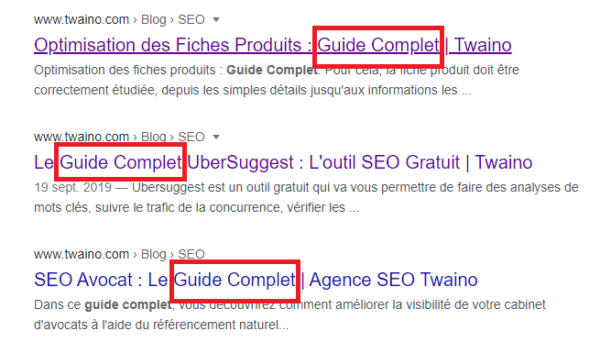
That’s why Guides {Complete | Ultimate | Definitive} work well.
Example: Widget For WordPress: The Ultimate Guide | Twino
2.2.15. Emphasize Speed (Saving Time)
One of the most powerful benefits to emphasize is saving time. Although this usually only applies to products, it can also be underlined in title tags.


Use words like:
- Quick;
- Quick ;
- Simple ;
- Etc.
Example: How to install WordPress easily in less than 5 minutes – Twaino
2.2.16. Test your titles
How do you know if the title tag is valid? To be certain of the result, you must use an effective tool. For this, I recommend using the SERP Simulator tool from twaino.
It is free and allows you to test and refine your titles before putting them online:
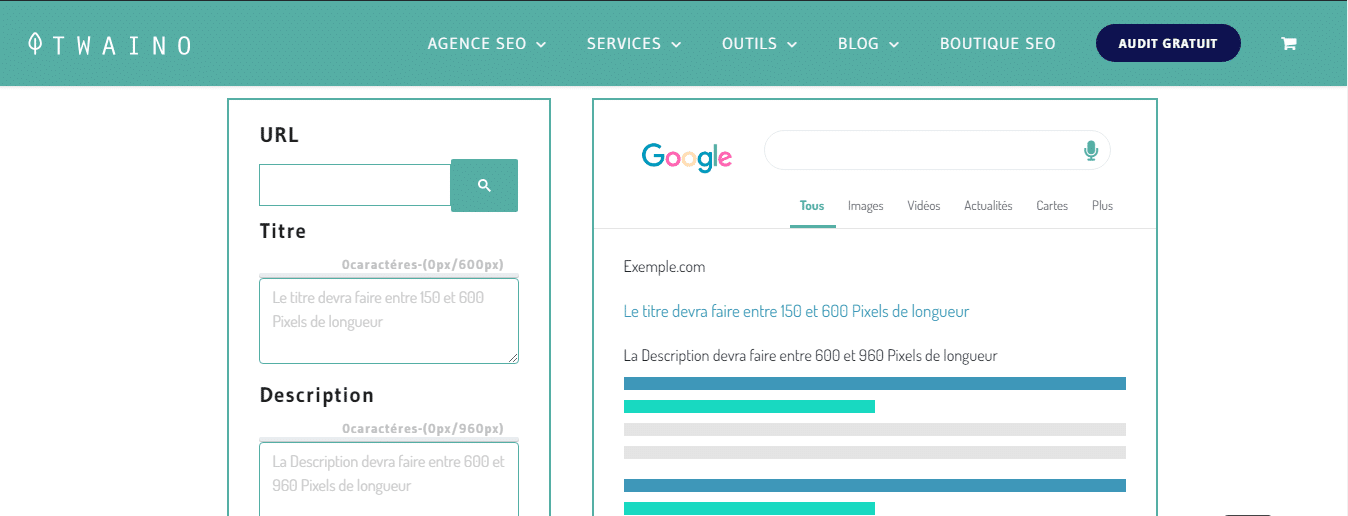
2.2. 17. Measure performance with Google Search Console
Google Search Console displays CTR data for your organic keywords. Just click on the “Performance” tab and you’ll have access to all sorts of useful data.
Although your CTR is not solely determined by your title tag, it is one of the most important factors. If you rank well, but your CTR is below average, you should test changing your title.
Here is a simple title tag testing framework that I use:
- Create 10-20 title tag variations;
- tool SERP Simulator to check;
- Execute the change;
- Annotate the change in Google Analytics;
- Wait (at least 3-4 weeks): You need to give Google time to re-crawl the page and see if there is any positive or negative impact.
The goal of these page title tests is toincrease CTR.Keep in mind: Navigational search terms (that are not your brand name) such as “Blogspot” will have a low CTR:

Changing your title tag won’t do much in this case because it’s intent-based.
On the other hand: Navigational search queries that ARE for your brand (brand search) must have a CTR exceptionally.
2.2.18. Be Realistic
All of these methods will help you optimize your title tags for optimal SEO performance.
But don’t forget:
Placing your main keyword in your title tag is a big ranking factor.
Think of it as the bare minimum to rank well.
KEEP IN MIND: Overall , write your title tags primarily for users, not search engines. Think about the most important search queries that apply to a page and use that to produce your title.
Before I end this article, I need to cover a few important questions:
Chapter 3: Other Questions Asked About the Title Tag
In this final chapter, I’m going to shed some light on some frequently asked questions:
3.1. What is the title tag?
The title tag is an HTML code tag that allows you to specify a title for a web page. This title appears in places like the title bar of browsers and in search engine results pages (SERPs).
It is crucial to add and optimize your website title tags as they play a vital role in terms of organic ranking (SEO).
3.2. Why is title tag optimization important for SEO?
Since the title tag is what appears in the SERPs, it’s important that it accurately reflects the content of the page and encourages people to click on it. It should also have keywords that tell search engines what the page is about.
3.3. Do I have to manually define all my title tags?
Normally, you write each title tag manually. For a website of a few hundred pages, this is still possible.
However, when you are managing an online store with thousands of products, it can become a tedious task and it is no longer realistic. In this case, it is more practical to automatically generate title tags that can be corrected manually if necessary.
3.4. How do I force search engines to use my title tag ?
Unfortunately, there is no way to force search engines to use the title tag you have defined. It is up to the search engine to decide whether or not it considers the meta title relevant to the user’s search.
However, when you find that search engines are not using your title tags, you can of course adjust them to make them more relevant to the search queries you are targeting.
3.5. I updated my title tag, why are search engines still showing the old one?
Chances are search engines haven’t visited your page since you made the changes. Search engines need some time to visit your page again and process the changes.
“But how long can that take? You will probably be asking yourself this question.
Well, it varies from page to page. Authoritative pages are visited more often than less authoritative pages. The delay varies from 2 minutes, a few days or more than a week. It really depends on your page.
3.6. Why aren’t search engines showing my title tag?
Your title tag is therefore clearly readable, unique, contains relevant keywords and is neither too long nor too short! Despite all this, your search engine may prefer not to display it.
Instead, they may display:
- One of your H1-H6 headers ;
- Or even just a few keywords and your brand name (A few keywords – Brand name).
These days, title listings are very dependent on the search term. When search engines think they know better, they ignore the page title you filled in and come up with a different, and not always relevant, title.
3.7. How to optimize the title tag for SEO?
To optimize the title tag for SEO, respect the following basic rules:
- Highlight your main keyword;
- Highlight the researcher’s intent;
- Make sure you have a unique title for each page;
- Use the terms of curiosities in your title tags;
- Use expressions like: Fast, easy, best, top…;
- Check the performance of your title before putting it online.
3.8. What is the ideal length for the title tag in Google?
The best solution is to respect the following interval for your title tags:
- Maximum length: 60 characters or 575 pixels ;
- Minimum length: 30 characters or 285 pixels.
3.9. Can the title tag and the H1 tag be the same?
In short, the answer is yes.
You should try to keep your tag H1 consistent with your title tag, but that doesn’t mean they have to be the same. Depending on the context, the title tag can be different or identical to the H1 tag. That is to say, it usually depends on the type of page you are creating and its purpose.
3.10.Google rewriting titles?
In fact, here’s what Google’s Gary Illyes said about it:
“ We’ll never give up rewriting titles. We’ve seen so many sites with really bad titles. Many sites do not have a title. Many others have a title saying “Top Page”. In fact, Google almost always rewrites titles. We couldn’t provide useful results to our users if we stopped rewriting titles. Experiences have shown us that users prefer written titles. So we will continue to write titles. – Gary Illyes ( Source )
3.11. What can you do to prevent Google from rewriting your title?
The #1 thing you can do is make sure your title matches the content/intent of your product page.
If your product page title is “Buy Shoes,” but your page is all about “Buy Blue Nikes,” Google will likely rewrite your title.
Your title tag must describe 100% of the content of your page while respecting the ideal length.
In summary:
The title tag is a short but very important part of On-page SEO. Even if they don’t require a lot of writing, don’t think you can rush through them anyhow.
Take the time and think about the best words you can use to communicate to search engines and potential visitors your page is about.
If done correctly, it can dramatically improve your rankings and increase your CTR hence the increase in organic traffic.
Nevertheless, be aware that a good page can rank without the title tag, but a perfect title tag will not have an impact if the content on the page is missing or of low quality.
To do this, produce good content and make sure your title tag accurately describes that content on your page.
That’s it for the title tags!
I hope you learned a lot from this guide to title tags.
If you got a lot of value from this article, please share it and leave a comment below as I answer every one of them. 🙂 See you
soon!

